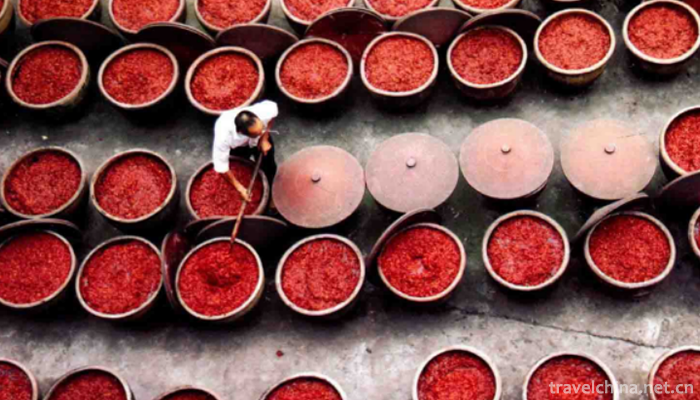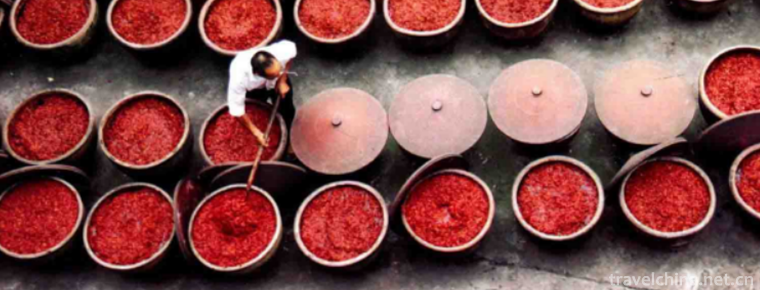Traditional Manufacturing Techniques of Bean Flap
Traditional Manufacturing Techniques of Bean Flap
Douban traditional craftsmanship, Pixian County, Sichuan Province, local traditional craftsmanship, one of the national intangible cultural heritage.
Pixian Douban originated in the reign of Kangxi in Qing Dynasty and has a history of more than 300 years. Pixian Bean Flap, adhering to the unique traditional technology, is made naturally by selecting local courgette and fresh chili pepper, together with flour and salt, and controlling the temperature at about 40 C after 3-5 months of maturity. The product has the characteristics of hot taste, mellow taste, crisp entrance of bean seed, sticky paste body, ruddy color, hot but not dry, mellow and long aftertaste.
In 2008, the traditional technology of bean paste production was approved by the State Council of the People's Republic of China and listed in the second batch of national intangible cultural heritage list, heritage number: _-155.
historical origin
In the early Qing Dynasty, a person surnamed Chen was living in Sichuan province. Under special circumstances, he mixed mouldy Hudou flaps with chili peppers and found that the taste was wonderful. After the Chen family settled in Pixian, they began to operate the brewing industry.
In the eighth year of Jiaqing in the Qing Dynasty (1803), Chen Yixian, the grandson of Chen's family, opened the Shuntian Sauce Garden in the West Street of the County Town.
In the third year of Xianfeng in the Qing Dynasty (1853), Chen Shouxin, the grandson of Chen Yixian, merged Shuntian with his shop in Nanjie to open Yifeng Sauce Garden. Chen Shouxin devoted himself to studying the craft of bean paste making, and summed up the 12-character secret of "sunshine, rain, day turn, night dew". Pixian's traditional handmade craft of bean paste has reached its perfection.
After the 31st year of Guangxu in Qing Dynasty (1905), Chen Zhuan, son of Chen Shouxin, carefully studied the proportion of pepper, coumarin and salt. After repeated practice, he improved the original technology of bean paste production, and developed black bean paste, golden hook bean paste, coumarin bean paste and other varieties.
In 1956, Pixian Douban Factory was established by public-private partnership with Yifenghe Sauce Garden as the main body.
Process characteristics
Pixian's coumarin (broad bean) is of good quality. It is processed as the main raw material to make bean paste, which is red and bright in oil, crisp in petals, has a strong hot taste, sweet and delicious. Besides being used as seasoning, it can also be served alone with cooked oil, and its taste is good.
Pixian Bean Flap is made of excellent raw materials, such as fresh red pepper, second-rate green broad bean, high-quality flour and refined edible salt. It is naturally refined and fermented noodles by long-term turning, sun-drying and dew. It has the characteristics of crisp petal residue, strong sauce fragrance, glossy reddish-brown oil, hot but not dry, moderate viscosity, long and mellow aftertaste.
Technological process
Pixian Bean Flap is brewed from small white broad bean produced in Neijiang, Sichuan, Erjin strip pepper produced in Jintang, Shuangliu and other real estate by unique brewing technology.
1. After peeling and removing impurities from broad beans, the beans are soaked in clear water until the beans have no wrinkles, no white heart on the cross-section and germinate. When the beans are in a germinating state, they can be peeled at 80-85C and soaked in 2% NaOH solution for 4-5 minutes. Then rinse with clear water to remove alkali.
2. The size and weight of flasked and peeled broad beans increased by 2-2.5 times and 1.8-2 times respectively, so that the meat could not be fresh.
3. In koji-making, broad beans are steamed in a steaming pot and mixed with flour at a ratio of 100:30. With 15%-30% seed koji added, they are moved into the koji chamber. Generally, the koji-making is ventilated for 2 days.
4. In sauce fermentation, the broad bean starter was moved into the fermentation tank, flattened and compacted slightly, and then naturally heated to about 40C. According to the ratio of 100kg broad bean starter to 140kg of 15Be brine, spraying wine into the starter, the temperature of brine should be 60-65C, and then sealed with a layer of salt. At this time, the product temperature can reach about 45C. After fermentation at this temperature for 10 days, the sauce grains are ripe. After the mash is ripe, add 8 kg salt and 10 kg water per 100 kg broad bean starter, stir evenly, and then ferment for 5 days.
5. Fresh chili peppers with chili sauce are peeled, washed and dried. Salt is added 22-24 kg per 100 kg. One layer of chili pepper is compacted with salt, and then a small amount of salt is used to cover the chilli sauce. The chilli is pressed with heavy material and salted for 3 months and then grinded. When grinding hot pepper, 20 Be brine can be added to adjust its consistency, and 1.5 kg hot pepper sauce can be produced at 1 kg.
6. After mixing the two kinds of sauces in proportion, heating and sterilizing them, and then putting them into pottery jar for half a month, they can be divided into finished products.
Inheritance and protection
Inheritance value
Pixian Douban plays an important role in Sichuan cuisine culture, and its traditional brewing techniques should be well inherited and developed.
From the nutritional point of view, Pixian Bean Flap is rich in protein, fat, carbohydrates, vitamin C and capsaicin. Long-term consumption can increase appetite, promote human blood circulation, and play a role in eliminating dampness and dispelling cold.
Inheriting characters
Lei Dingcheng, the third batch of representative inheritors of national intangible cultural heritage projects, declared the project in Pixian, Chengdu, Sichuan Province: traditional production technology of bean paste (traditional production technology of Pixian bean paste).
protective measures
In 1997, "Pixian Douban" applied for registration of geographical indication certification trademark of "Pixian Douban" in the name of Pixian Food Industry Association of Chengdu, and formally approved registration on April 21, 2000. In 2001 and 2006, the Pixian Food Industry Association of Chengdu applied to the Trademark Office for registration of four geographical indications certification trademarks in different combinations of county names and general names.
In order to strengthen management, Chengdu Pixian Food Industry Association has formulated "Detailed Rules for the Implementation of the Management of the Geographical Indication Certification Trademark of Pixian Douban" according to the "Pixian Douban" Geographical Indication Certification Trademark Management Rules". The enterprises authorized to use the"Pixian Douban"Geographical Indication Certification Trademark are subdivided and managed. At the same time, enterprises are organized to hold symposiums to strengthen information exchange. It improves the brand awareness of enterprises.
In 2010, Pixian Douban was listed as the key brand development plan of Sichuan pickle industry by Sichuan provincial government.
social influence
Since 2006, the Pixian Food Industry Association of Chengdu has organized enterprises to participate in various trade fairs and food exhibitions in the United States, Thailand, Japan, Australia, South Korea and other countries and regions.
Pixian Douban won the title of Top Ten Geographical Indicators in Sichuan Province in 2007.
In 2018, the China Brand Building Promotion Association released the brand value statistics of geographical indications products in China, and Pixian Douban brand ranked first in Sichuan in succession.
Pixian Douban was widely marketed in Hunan, Hubei, Yunnan, Guizhou, Tibet, Shaanxi and Gansu during the Republic of China. In 1916, it was awarded the first prize by the Sichuan Provincial Council for Promoting Industry.
In 2012, Pixian bean paste was sold all over the country, and exported to the United States, Canada, New Zealand, Japan, Britain, Taiwan, Hong Kong and other countries and regions.


-
1.Ali Mountain
Mount Alishan, located 75 km east of Jiayi City, Taiwan Province, is located at an altitude of 2,216 meters. Its coordinates are 23 degrees north and 31 minutes east
Time 2018-10-30 -
2.Guangzhou soup
Guangzhou old fire soup is a traditional and famous dish, which belongs to Guangdong cuisine.
Time 2018-11-14 -
3.Shangyao National Forest Park
Shangyao National Forest Park, located in the northeast of Huainan City, Anhui Province, has more than 30 hills and mountains with a total area of 10.4 square kilometers and a forest coverage rate
Time 2018-12-19 -
4.Jindian Scenic Spot
Kunming Golden Palace Scenic Spot, also known as Tongwa Temple, is made of brass and shines in the sunshine, reflecting the golden brilliance of Cuigou Youlin
Time 2019-01-22 -
5.Anshun land Opera
Anshun Dixi Opera, a local traditional drama in Anshun City, Guizhou Province, is one of the national intangible cultural heritage.
Time 2019-04-01 -
6.Legend of Cang Jie
Cangjie Legend is an ancient Chinese folklore. The story of Cangjie's writing originated from the Yan and Huang Dynasties and has a history of 5,000 years. Legend has it that in
Time 2019-04-04 -
7.Eighteen Butterflies
Eighteen butterflies is a local traditional dance form popular in the central part of Zhejiang Province (mainly in the area of Jinhua Yongkang). Twenty young women play the whole set of eighteen butte
Time 2019-06-15 -
8.The Legend of Shun
Shun was born in Zhufeng Village, Yongji County. His surname is Yao and his name is Chonghua because of his double pupils. Soon after his mother gave birth, he died. His father married a stepmother an
Time 2019-06-16 -
9.Tajik Water Diversion Festival and Seeding Festival
In Tashkurgan Tajik Autonomous County of Xinjiang, Tajik Water Diversion Festival and Seeding Festival are Tajik agricultural festivals. In Tajik, the sowing Festival is called "Hamozivast"
Time 2019-06-17 -
10.Bai Pu
Bai Po (1226 - about 1306), formerly known as "Heng", Ren Fu, later renamed Pu, the word is too plain, Lanlan Valley, Han nationality, ancestral home state (now Shanxi) Hequ ) Nanjing's Kaif
Time 2019-09-11 -
11.Panzhihuas primary industry
In 2018, the total output value of agriculture, forestry, animal husbandry and fishery in Panzhihua was 7.027 billion yuan, an increase of 4.2%. Among them, agricultural output value was 4.434 billion yuan, an increase of 5.2%; forestry output value was 108 million yuan, an increase
Time 2020-12-14 -
12.History of Leshan
Leshan used to be the capital of Kaiming tribe in ancient Shu state. In 309 B.C., King Wu of Qin sent troops to the south to wipe out the rule of the Kaiming family. The state of Qin established Nan'an County in Shizhong District of Leshan City
Time 2020-12-17